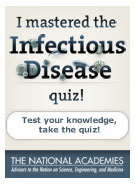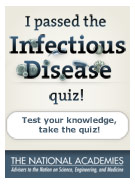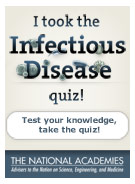
What You Need To Know About Infectious Disease
What do you know about infectious disease?
Which deadly pathogen cannot be found naturally in the wild:
-
Sorry, that’s incorrect.
Smallpox cannot be found naturally in the wild. Smallpox was officially declared eradicated from the globe in 1980, after an 11-year WHO vaccination campaign—the first human disease to be eliminated as a naturally spread contagion. Today, the virus remains only in laboratory stockpiles.
-
Sorry, that’s incorrect.
Smallpox cannot be found naturally in the wild. Smallpox was officially declared eradicated from the globe in 1980, after an 11-year WHO vaccination campaign—the first human disease to be eliminated as a naturally spread contagion. Today, the virus remains only in laboratory stockpiles.
-
Correct!
Smallpox cannot be found naturally in the wild. Smallpox was officially declared eradicated from the globe in 1980, after an 11-year WHO vaccination campaign—the first human disease to be eliminated as a naturally spread contagion. Today, the virus remains only in laboratory stockpiles.
For each child who dies from pneumonia in an industrialized country, about how many children die from the infection in developing countries?
-
Sorry, that’s incorrect.
Life-saving vaccines and medications aren’t distributed equitably around the world; for each child who dies from pneumonia in an industrialized country, more than 2,000 children die from the infection in developing countries.
-
Sorry, that’s incorrect.
Life-saving vaccines and medications aren’t distributed equitably around the world; for each child who dies from pneumonia in an industrialized country, more than 2,000 children die from the infection in developing countries.
-
Sorry, that’s incorrect.
Life-saving vaccines and medications aren’t distributed equitably around the world; for each child who dies from pneumonia in an industrialized country, more than 2,000 children die from the infection in developing countries.
-
Correct!
Life-saving vaccines and medications aren’t distributed equitably around the world; for each child who dies from pneumonia in an industrialized country, more than 2,000 children die from the infection in developing countries.
What fraction of all deaths worldwide are caused by infectious disease?
-
Sorry, that’s incorrect.
About one quarter of all deaths worldwide are caused by infectious disease. More than two-thirds of the deaths in children under the age of five are caused by infectious disease.
-
Correct!
About one quarter of all deaths worldwide are caused by infectious disease. More than two-thirds of the deaths in children under the age of five are caused by infectious disease.
-
Sorry, that’s incorrect.
About one quarter of all deaths worldwide are caused by infectious disease. More than two-thirds of the deaths in children under the age of five are caused by infectious disease.
Of the more than 1,700 known viruses, bacteria, and other pathogens that infect people, how many have come from animals?
-
Sorry, that’s incorrect.
More than half of the known pathogens that infect people have come from animals. Of the 37 new infectious diseases identified in just the past 30 years, two-thirds sprang from animals.
-
Sorry, that’s incorrect.
More than half of the known pathogens that infect people have come from animals. Of the 37 new infectious diseases identified in just the past 30 years, two-thirds sprang from animals.
-
Correct!
More than half of the known pathogens that infect people have come from animals. Of the 37 new infectious diseases identified in just the past 30 years, two-thirds sprang from animals.
True or False: Washing your hands with soaps that have residue-producing antibacterial products, such as those containing the chemical triclosan, have been proven to confer health benefits.
-
Sorry, that’s incorrect.
Washing with regular soap is considered the most important way to prevent disease transmission. Routine consumer use of residue-producing antibacterial products has no added benefit and may actually contribute to antibiotic resistance.
-
Correct!
Washing with regular soap is considered the most important way to prevent disease transmission. Routine consumer use of residue-producing antibacterial products has no added benefit and may actually contribute to antibiotic resistance.
Which are larger?
-
Correct!
Bacteria are 10 to 100 times larger than viruses.
-
Sorry, that’s incorrect.
Bacteria are 10 to 100 times larger than viruses.
True or False: Most infectious diseases are not impacted by changes in the environment.
-
Sorry, that’s incorrect.
Most infectious diseases are impacted by changes in the environment. Malaria, dengue, and viral encephalitis infections, for example, are highly sensitive to environmental changes.
-
Correct!
Most infectious diseases are impacted by changes in the environment. Malaria, dengue, and viral encephalitis infections, for example, are highly sensitive to environmental changes.
Which of the following is NOT a type of infectious agent?
-
Sorry, that’s incorrect.
White blood cells are not a type of infectious agent. Part of the immune system, white blood cells fight infection rather than cause it.
-
Sorry, that’s incorrect.
White blood cells are not a type of infectious agent. Part of the immune system, white blood cells fight infection rather than cause it.
-
Correct!
White blood cells are not a type of infectious agent. Part of the immune system, white blood cells fight infection rather than cause it.
-
Sorry, that’s incorrect.
White blood cells are not a type of infectious agent. Part of the immune system, white blood cells fight infection rather than cause it.
Which of the following diseases is NOT caused by a virus?
-
Sorry, that’s incorrect.
Tuberculosis is caused by a bacterial infection. Chicken pox, the common cold, and influenza are all caused by viral infections.
-
Sorry, that’s incorrect.
Tuberculosis is caused by a bacterial infection. Chicken pox, the common cold, and influenza are all caused by viral infections.
-
Sorry, that’s incorrect.
Tuberculosis is caused by a bacterial infection. Chicken pox, the common cold, and influenza are all caused by viral infections.
-
Correct!
Tuberculosis is caused by a bacterial infection. Chicken pox, the common cold, and influenza are all caused by viral infections.
Thank you for taking our quiz.
Place this badge on your Facebook page to show your friends what you know about infectious disease.
Place this badge on your Facebook page to show your friends what you know about infectious disease.
OR, get a higher score to unlock a different badge.
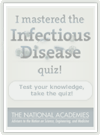
Place this badge on your Facebook page to show your friends what you know about infectious disease.
OR, get a higher score to unlock a different badge.
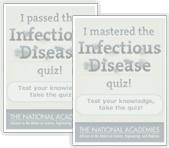
Explore Other Topics
Disease Watchlist
Infectious Disease Defined
- Recombinant Technology
The process that allows technicians to create artificial pieces of DNA in which two or more DNA sequences, often from separate organisms, are combined in ways that would not normally occur naturally.
